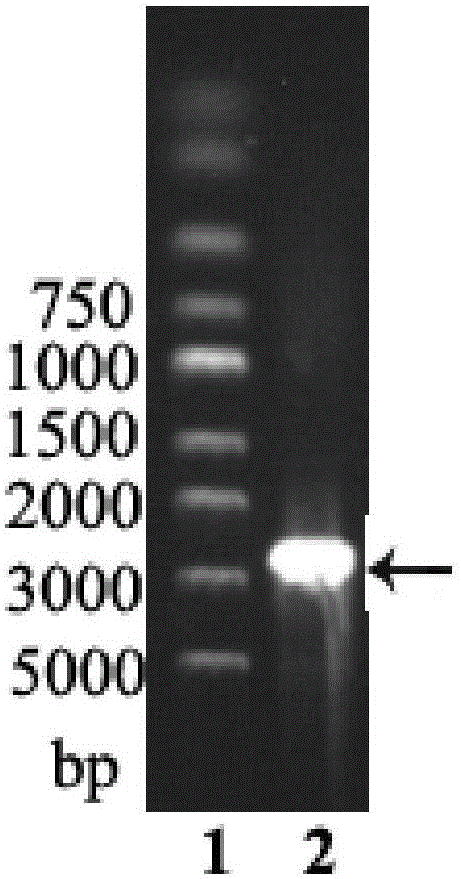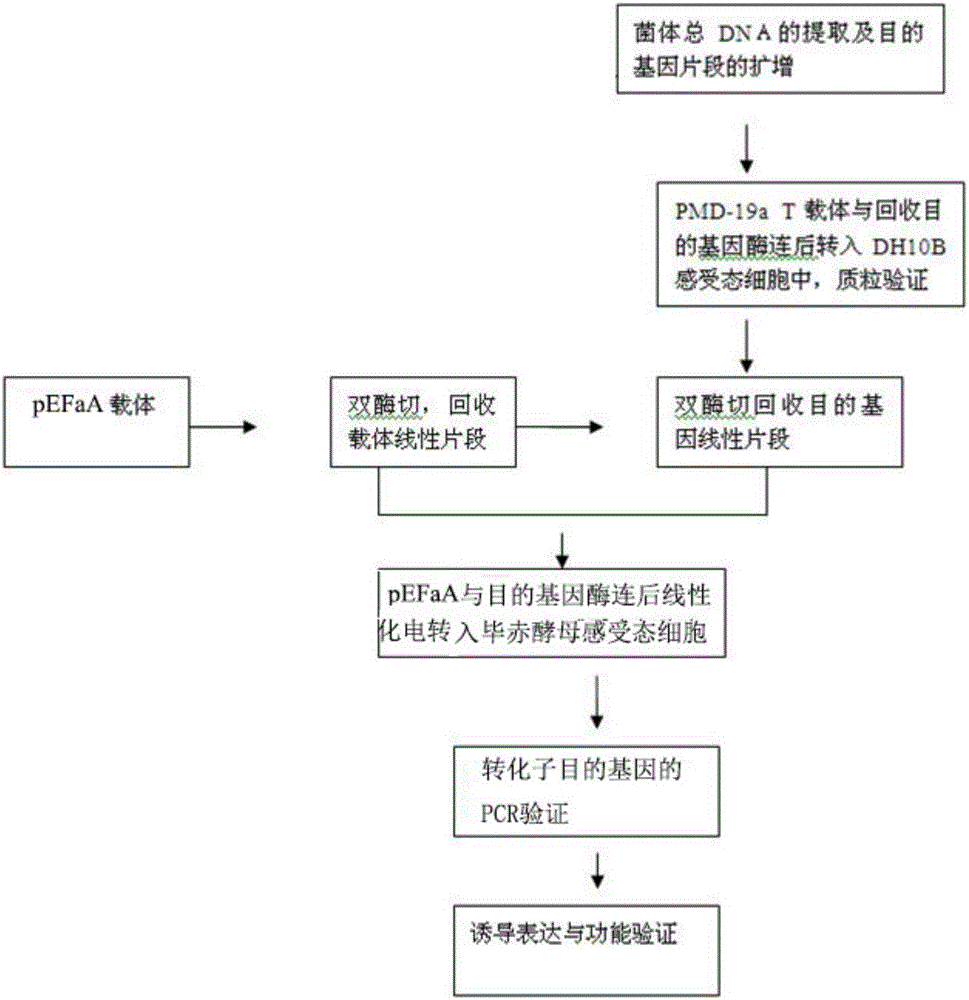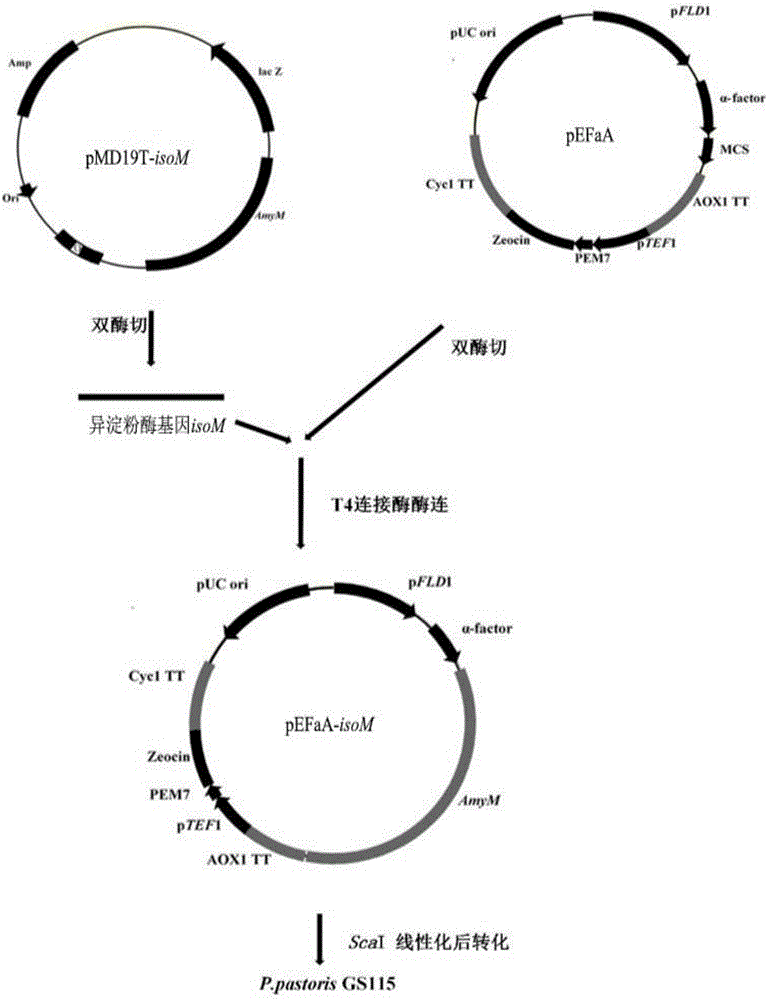Isoamylase, gene of isoamylase, engineering bacterium with gene and application of gene
A technology of isoamylase and starch processing, which is applied in the direction of genetic engineering, application, plant gene improvement, etc., and can solve problems such as unrealized industrial production
- Summary
- Abstract
- Description
- Claims
- Application Information
AI Technical Summary
Problems solved by technology
Method used
Image
Examples
Embodiment 1
[0035] The cloning of embodiment 1 isoamylase gene and the construction of expression vector
[0036] 1.1 PCR amplification of isoamylase gene
[0037] Referring to the Myxobacteria EGB genome sequence and combined with NCBI genome information for ORF prediction, design primers for the isoamylase gene based on the full-length sequence, and use the genomic DNA of EGB bacteria (CCTCC NO: M2012528) as a template to perform PCR for the full length of the isoamylase gene Amplify to obtain the full-length sequence of the isoamylase gene, the primers used are F and R, the results are shown in figure 1 . Refer to the specific process figure 2 .
[0038] F: ctcgagAAAAGAGAGGCTATGACCCCCTCCCCGTCGTCAC(XhoI) (SEQ ID NO. 5)
[0039] R: tctagaCTTGGCCACCAACACCAGC (XbaI) (SEQ ID NO. 6)
[0040] 1.2 Preparation of E.coli DH10B electroporation competent
[0041] Streak the strain E.coli DH10B from the ‐80°C refrigerator on a fresh LB plate, culture overnight, pick a colony with a diameter ...
Embodiment 2
[0068] Example 2. High expression of isoamylase gene in P.pastoris GS115 (pEFaA-Iam)
[0069] 2.1 Expression of isoamylase IaM
[0070] Culture the expression strain P.pastoris GS115 (pEFαA‐IaM) on a streak plate, pick a single colony into a 50mL liquid YPD flask, culture at 28°C, 200rpm for 24h; then centrifuge at 4000rpm for 5min at room temperature, and discard the supernatant , resuspend the bacteria with 25mL BMMY medium, and start to induce the expression of yeast cells; continue to culture at 28°C, 200rpm, add methanol every 24h to a final concentration of 0.5% (v / v), and co-cultivate for 96h; After the culture was over, the enzyme activity of the target protein was detected, and it was found that the expression level of the isoamylase reached 0.5 μg / mL.
[0071] 2.2 Protein electrophoresis SDS-PAGE identification and renaturation zymogram
[0072] Protein samples were subjected to 12% polyacrylamide gel electrophoresis (SDS-PAGE). After electrophoresis, the lanes con...
Embodiment 3
[0073] Example 3. Research on Enzymatic Properties of Isoamylase
[0074] 3.1 Effect of temperature on enzyme activity
[0075] Determination of the optimum reaction temperature: at different temperatures (20°C, 30°C, 40°C, 45°C, 50°C, 55°C, 60°C, 70°C), the activity of the purified enzyme of the recombinant enzyme was measured under the conditions of pH 7.0, Set the highest enzyme activity to 100% ( Figure 5 a). Determination of thermal stability: Incubate the recombinant enzyme purified enzyme solution at 20°C, 30°C, 40°C, 45°C, 50°C, 60°C, 70°C, and pH 7.0 for 1 hour, take samples every 10 minutes, and quickly place on ice After cooling, measure the residual enzyme activity respectively, and take the unincubated enzyme activity as 100% ( Figure 5 b). It has been determined that the optimum reaction temperature of the amylase is 45°C, and it remains stable between 20°C and 45°C.
[0076] 3.2 The effect of pH on enzyme activity
[0077] Determination of the optimum re...
PUM
| Property | Measurement | Unit |
|---|---|---|
| Specific vitality | aaaaa | aaaaa |
Abstract
Description
Claims
Application Information
 Login to View More
Login to View More - R&D Engineer
- R&D Manager
- IP Professional
- Industry Leading Data Capabilities
- Powerful AI technology
- Patent DNA Extraction
Browse by: Latest US Patents, China's latest patents, Technical Efficacy Thesaurus, Application Domain, Technology Topic, Popular Technical Reports.
© 2024 PatSnap. All rights reserved.Legal|Privacy policy|Modern Slavery Act Transparency Statement|Sitemap|About US| Contact US: help@patsnap.com










